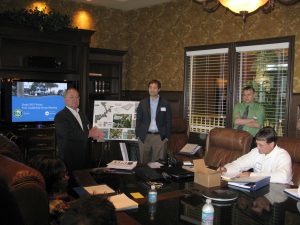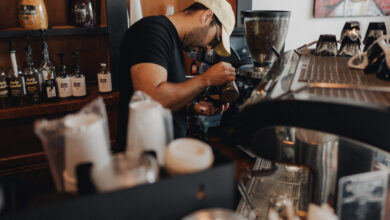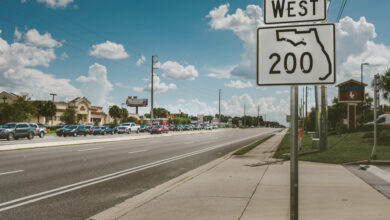
Almost 10 years after the initiation of The Ocala 2035 Vision, an ambitious plan to build up Ocala’s infrastructure to support growth, it is time for a checklist to see how we’ve done. The City of Ocala and Marion County receive high marks on execution.
By John Sotomayor
It was a turning point for our city. Those appointed to the redevelopment of Ocala got out of the sand — literally — back in gear toward prosperity. Like a colony of worker ants, the people of Ocala unified to build upon its colony. City and county officials, as well as community activists, united together on a common cause — to establish a long-term plan for urban development to best serve the growth of our community on the city and county levels. They established a Citizen Leadership Group that led months of public meetings and design workshops, focus group discussions, and outreach committees to research other communities’ successfully applied ideas. On October 19, 2010, the City of Ocala City Council adopted the community-completed plan known as The Ocala 2035 Vision.
According to the city of Ocala website, The Ocala 2035 Vision “served as the basis for identifying community design values and issues for the community’s required Comprehensive Plan Evaluation and Appraisal Report (EAR), urban form and design policies in the community’s Comprehensive plan, and new standards for design in the community’s development codes and design guidelines.”
“Ocala has come a long way over the past decade,” said City of Ocala Mayor Kent Guinn. “It has followed the plan to the letter, remaining on schedule.”
“If you want to see how well we’ve done, just look at The Ocala 2035 Vision,” added City Manager John Zobler. “You can see what was planned for each year and actually check them off the list as done.”
That says a great deal, given previous missteps. Does anyone remember The Sandbox? It was supposed to be the City Shops & Walk, to be built downtown where the luxe condo apartments known as 302 Broadway and parking garage now stand, however South Florida developer Jorge Gutman ran into several problems that stalled the development for years. In 2009, the City of Ocala purchased the land back in a foreclosure sale for $100. Since then, development was enacted and maintained efficiently.
Following what Zobler suggested, a check list of The Ocala Vision 2035 reveals what has been accomplished to date, and what is on the horizon.
Downtown Makeover
The Ocala Vision 2035 had some very specific items for downtown redevelopment to make it a more family and user-friendly area to interact. Community Redevelopment Area (CRA) grant dollars were used by the downtown businesses for interior and exterior improvements. For quality of place, they added cultural arts and murals.
For operational excellence, public art displays and the Magnolia Art X-change, located at the former train station, were added in the Tuscawilla Park area by 2015, and the adjacent Tuscawilla Art Park in 2018.
For fiscal sustainability and quality of living, the former Sprint Building was converted to the 302 Broadway contemporary luxury lofts. As an economic hub, the Ocala Downtown Market was created in 2016, and the Osceola Rail was repaired, converted to a linear park. Magnolia Avenue added Lofts on the Square, Olive Market, and Brick City Southern Kitchen.
The long-awaited Downtown Parking Garage also opened in 2016. The South Magnolia Mobility Improvement, which included repaving the road from Broadway to Fort King with cobblestone, accentuating the streets with artisan lamp posts was done the following year in 2017. The Historic Fort King Reconstruction was also unveiled in 2017.
Citywide
As part of the economic hub plan, Fed Ex began construction on the FedEx Ground Package System Inc in 2015 at the Ocala 489 Commerce Park. Soon after, AutoZone Distribution Center built its own distribution center in 2017, and Chewy.com followed in 2018.
The Ocala Business Park was built at the Ocala International Airport around that time. The Florida Crossroads Commerce Park on County Road 484 west of Interstate 75 near Marion Oaks began in 2018.
The Septic Tank Abandonment Program began June 2015. It was supposed to be completed by June 2017, but was extended to June 2018. The total cost came to $10 million, split $2.5 million by St, Johns River water Management District (SJRWMD), $2.5 million by the Florida Department of Environmental Protection (FDEP), and $5 million by the city of Ocala.
Midtown Makeover
There were several challenges to recreate midtown, the area just north of SR 40 up to southern part of Tuscawilla Park. The area had several dominant uses that lacked synergy, as well as deterioration of the existing neighborhoods. There were waves of disinvestment, plus connectivity and mobility issues, lack of social gathering spaces, and absence of residential and commercial living.
To counter the problems and reinvigorate midtown, the city made its most significant investments. The game changer was the grand opening of the Reilley Arts Center in the renovated almost-80-year-old City Auditorium at Tuscawilla Park. The venue attracted A-list performers from across the nation and world, as well as provided a central location for local talent to perform. The Reilley was only the beginning of the area’s remarkable transformation.
On Feb 5, 2019 the city opened the new First Responder Campus on 8th Avenue, with adjacent fire and police stations on the site. There are plans on the horizon to convert the Fire Station One off Tuscawilla Park into a brewery and concessions, where patrons of the park concert series and other attractions can find refreshments.
The parking lot north of SR 40 between 1st Ave and Magnolia Ave is planned to become the Concord Lot, a plaza with tables and seating so that people can congregate as they do in larger cities, a popular concept in Europe.
Coming Soon in 2019
There are redevelopments happening this year countywide. A new terminal at Ocala International Airport is expected to be completed in the summer 2019. In the midtown area, an Open-Air Pavilion and Engagement Center is planned to provide services for transients. Construction is under way on the Osceola Multimodal Connection that will stretch from Ocala Downtown Market to Tuscawilla Park, providing a pedestrian pathway.
2019 will prove transformational for West Ocala. Three critical areas have been targeted for investment: the MLK First Responders Campus, between 7th and 5th Streets off Martin Luther King Ave (budgeted at $6.5 million), Croskey Commons, located on Martin Luther King Blvd between SR 40 and NW 7th Street (budget is $9.6 million), and a community center at Royal Oak (budgeted at $6.5 million).
Blight Removal
In order to fully benefit from improvements made to a city, it is vital to also remove the urban decay known as blight. Potential businesses and residents will hesitate to relocate if the city is covered in eye-sores. Blight is not good for business.
The City of Ocala has demolished the former Quality Inn Site on SR 40 and I-75. It has also removed blight that formerly dotted North Magnolia, known as “the Miracle Mile.” New retail centers have rooted or are planned throughout the county, such as Paradise Park Retail Center.
On the Horizon
The central focus downtown is on the Hilton Garden Inn, a downtown mixed-use development project by developer Danny Gaekwad for an alluring hotel with residential units, boutique shops, and five-star restaurants within.
By January 2020, the Hilton Garden Inn will open its doors, forever changing the look and feel of downtown Ocala. Commerce will be robust, and the community will be full of life. With all that has been accomplished in the first 10 years of the 25-year plan, the next 15 years should be remarkable.
For starters, the World Equestrian Center currently under way on the grounds of Golden Ocala Golf & Equestrian Club. The behemoth, five-star world class resort is slated to open in Jan 2021. The inclusion will solidify Ocala as the ultimate destination for world travelers attracted by everything equestrian. The possibilities are limitless. The path already laid.
Arts & Economic Prosperity Study
In July 2017, the City of Ocala was selected by Americans for the Arts to take part in the 5th Arts and Economic Prosperity Study (AEP5). The purpose was to define the economic impact of arts and culture on Ocala, and all of Marion County.
The study revealed the following:
- Total industry expenditures were $56 million
- Total collective economic impact is 1422 FTEs
- Revenue to our local government was $2.4 million
- Revenue to our state government was $3.7 million






